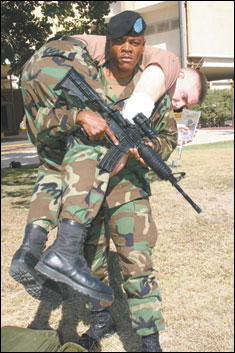|
This video was produced by the US
Army in 1994 to assist in instructing medical providers in the use of
radio communications to arrange medical evacuation.
This video describes each of the 9
lines used to format a MEDEVAC request..
The video may be freely
downloaded.
MEDEVAC 9 Line Request Voice Template
Example:
a)
"CharlieMed, this is Echo-2-Niner,
over".
b)
"Echo-2-Niner, this is Charlie-Med,
send over".
c)
"This is Echo-2-Niner, request
medevac, over".
d)
"Echo-2-Niner this is Charlie-Med,
authenticate Yankee, over".
e)
"Charlie-Med, this is Echo-2-Niner,
I authenticate Champion, over".
f)
"Roger Echo-2-Niner, send request
over".
g)
“Roger, nine line as follows,
break,”
h)
“ONE, Tango-alpha 6577, break”
i)
“TWO, 39.39,E-7-Romeo, break”
j)
“THREE, 1-Charlie, 2-Delta, break”
k)
“FOUR, Alpha, break”
l)
“FIVE, Lima-1, Alpha-2, break”
m)
“SIX”, November, break”
n)
“SEVEN, Green smoke, break”
o)
“EIGHT, US military, break”
p)
“NINE, Large raising hills to the
north, and south with wires to the north running east to west, over.”
From CASUALTY EVACUATION,
FMST 0503, 17 DEC 99, Field
Medical Service School, Camp Pendleton, California
|

MEDEVAC REQUEST (9 Line Brief):
a.
Medical evacuation request
transmisions should be by the most direct communication means
available to the medical unit controlling evacuation assets. The
means and frequencies used will depend on the organization,
availablity, and location in the area of operations, as well as the
distance between units. The primary and secondary frequency for
medevac requests will be specified by the unit evacuation plan.
b.
The information must be
clear, concise, and easily transmitted. The is done by use of the
authorized brevity code. The authorized brevity code is a series of
phoenetic letters, numbers, and basic descriptive terminology used to
transmit medevac information.
c.
Under wartime conditions and
for training purposes this includes radio frequency encryption and the
use of authorized brevity codes. These codes indicate the standard
information required for a medevac commonly known as the “9 Line
Brief”.
d.
This brief is verbally
transmitted in numerical “line” sequence utilizing the authorized
brevity codes as follows:
1.
Line “One”:
a)
Location of pickup site in
descripitive terms – encrypted grid coordinates.
b)
Coordinating unit will
provide planned route if casualties are located in more than one
location.
2.
Line “Two”:
a)
Radio frequency, call sign,
and suffix – Encrypted frequency of requesting unit and suffix of
person to be contacted as needed.
3.
Line “Three”:
a)
Number of patients by
precedence – Reported only as medevac categories applicable with
encrypted brevity codes:
1)
“A”+ # - Urgent.
2)
“B”+ # - Urgent Surgical.
3)
“C”+ # - Priorty.
4)
“D”+ # - Routine.
5)
“E”+ # - Convenience.
b)
If two or more categories
are reported in the same request, the word “BREAK” is to be verbalized
between each category.
4.
Line “Four”:
a)
Special Equipment Required:
1)
“A”- None.
2)
“B”- Hoist.
3)
“C”- Extraction equipment.
4)
“D”- Ventilator.
5.
Line “Five”:
a)
Number of patients by types-
Litter or ambulatory:
1)
“L” + number of patients.
2)
“A” + number of patients.
b)
Report applicable info only
and if requesting for both types, use “BREAK” between entries.
6.
Line “Six”:
a)
Wartime- Security of pick up
site:
1)
“N”- No enemy troops
present.
2)
“P”- Possible enemy in
area, approach with caution.
3)
“E”- Enemy troops in area,
appraoch with caution.
4)
“X”- Enemy troops in area,
armed escort required.
b)
Peacetime- Number and
descriptive type of wound, injury or illness.
7.
Line “Seven”:
a)
Method of pick up site
marking- Ensure encrypted especially during wartime:
1)
“A”- Panels.
2)
“B”- Pyrotechnic signal.
3)
“C”- Smoke signal.
4)
“D”- None.
5)
“E”- Other, specify.
8.
Line “Eight”:
a)
Patient nationalty and
status - The number of patients in each of the below does not need to
be transmitted:
1)
“A”- US Military.
2)
“B”- US Civilian.
3)
“C”- Non-US Military.
4)
“D”- Non-US Civilian.
5)
“E”- Enemy prisoner of war (EPW).
9.
Line “Nine”:
a)
Terrain description -
Descriptive details of terrain features and there relationship in and
around proposed landing site (lakes, mountains wires, etc.).
b)
Wartime - Include as
applicapable, NBC contanimation:
1)
“N”- Nuclear.
2)
“B”- Biological.
3)
“C”- Chemical.
From CASUALTY EVACUATION,
FMST 0503, 17 DEC 99, Field
Medical Service School, Camp Pendleton, California
|

